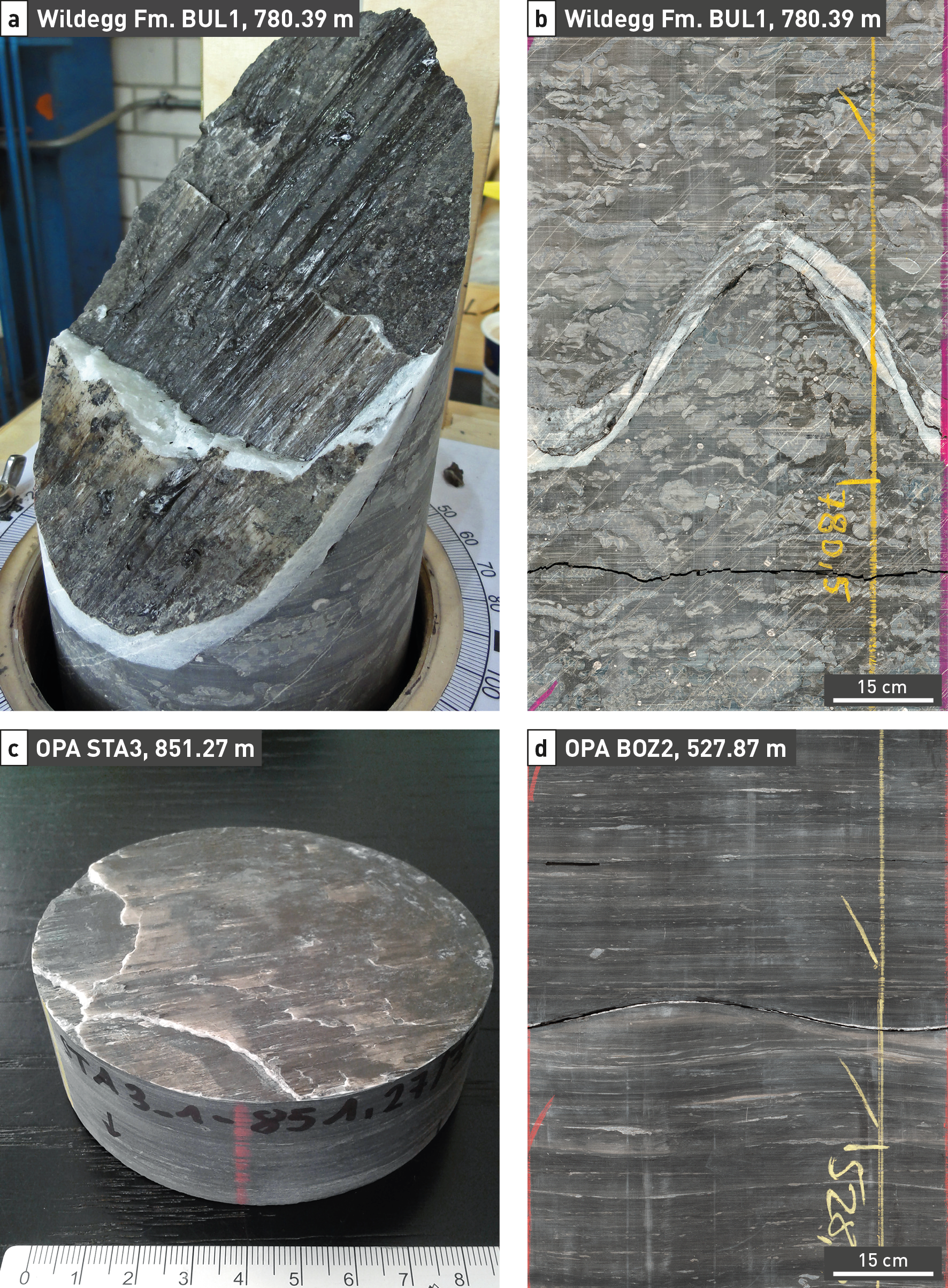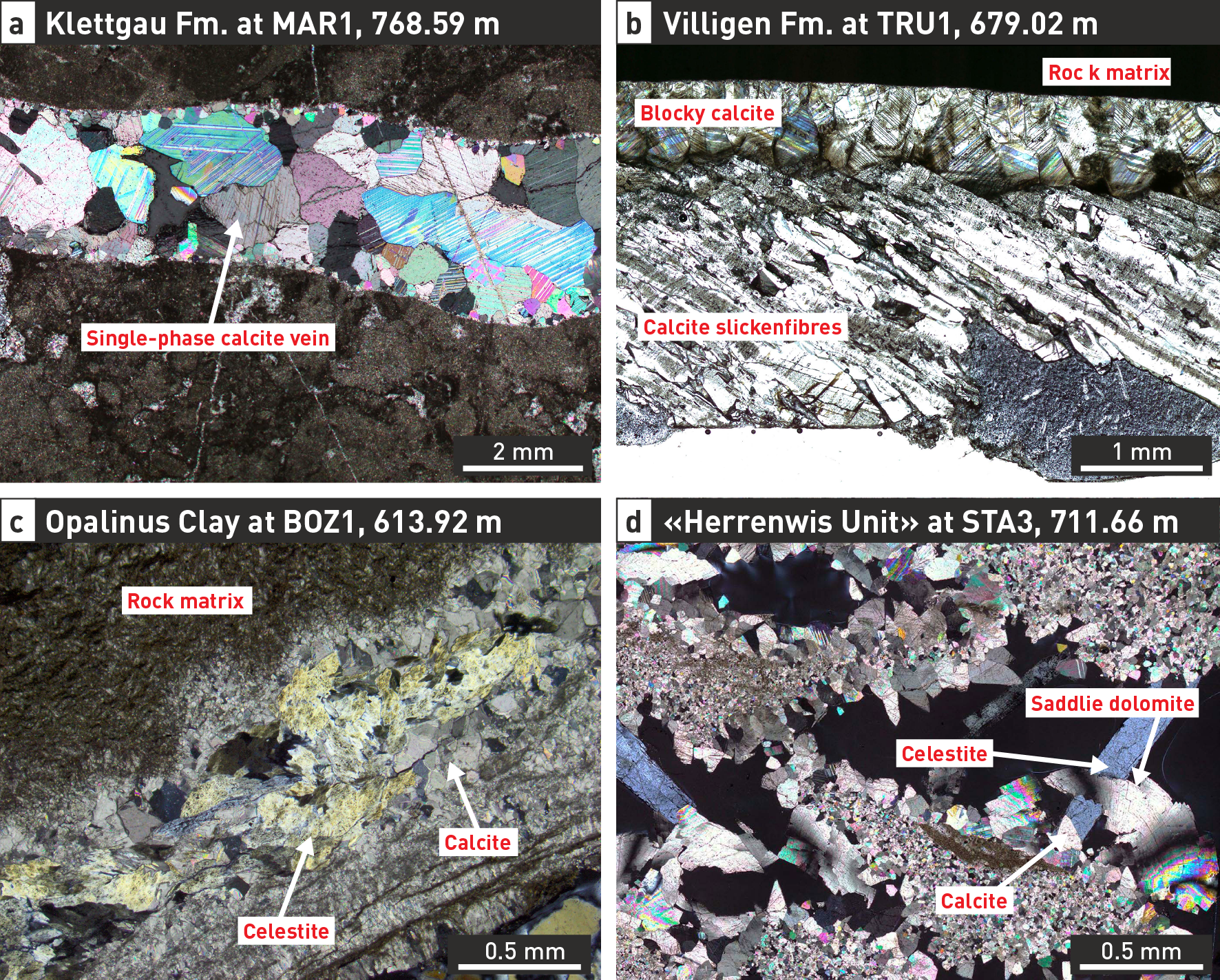In general, two different types of mineralisation were distinguished: 1) infills of primary macropores mainly observed in the Upper Dogger («Herrenwis Unit») and the Lias (Staffelegg Formation) and 2) tectonic mineralisations associated with fractures, i.e. veins. The latter are unevenly distributed over the Mesozoic sequence. The greatest density of veins is observed in the competent carbonates of the Malm Group (Section 4.3.4, Fig. 4‑61, Fig. 4‑65, Fig. 4‑69), where they can attain thicknesses of a few centimetres (Fig. 4‑127a, b). The less competent, clay-mineral-rich Dogger – Lias units show distinctly fewer veins, the Opalinus Clay in particular shows only few. Most of these veins are between 0.5 – 3 mm thick (Fig. 4‑127c, d) and are mainly found in narrow zones (1 – 2 metres thick). Between such zones, the Opalinus Clay is essentially free of veins.
In general, mineralisation is associated with micro faults (i.e. slickenfibres) or within extensional joints and tension gashes (e.g. blocky calcite with no shear or slip indicators). The investigated veins exhibit a large variation in orientation, reflecting the polyphase deformation history of Northern Switzerland (Section 4.3 and Chapter 3; Akker et al. 2023).

Fig. 4‑127:Examples of veins from the TBO boreholes
(a) Reverse micro fault with cm-thick synkinematic calcite in the Malm Group of the BUL1 borehole (from Nagra (ed.) 2021a, Dossier V). (b) 360° core photograph of the same structure (from Nagra (ed.) 2021a, Dossier V). (c), (d) Reverse micro fault with mm-thick synkinematic calcite in the Opalinus Clay of the STA3 and BOZ2 boreholes, respectively.
Information on the petrography of secondary mineralisations in the Dogger – Keuper interval for various sites across Northern Switzerland (i.e. older boreholes of Nagra and SEAG, Mont Terri) is documented in a variety of reports and publications, which are compiled and summarised by Mazurek & Aschwanden (2020). The TBO boreholes yielded a similar inventory of vein-filling minerals as observed in nearby older boreholes, including calcite, which is consistently present at all investigated sites and constitutes the dominant infill of veins. Calcite vein-fillings are either single-phase (Fig. 4‑128a) or they contain multiple generations, the latter reflecting polyphase deformation and precipitation (Fig. 4‑128b; see also Akker et al. 2023). Additionally, there are minor occurrences of celestite (Fig. 4‑128c) and pyrite as vein-infills, mainly in the Dogger Group above Opalinus Clay and in the Opalinus Clay itself. Also, there are minor occurrences of dolomite with saddle habitus as pore infills in the «Herrenwis Unit» (Fig. 4‑128d).

Fig. 4‑128:Mineralised structures in the Opalinus Clay and other Mesozoic units
(a) Single-phase calcite vein (cross-polarised transmitted light microscopy). (b) Two calcite generations representing polyphase deformation (plane-polarised transmitted light microscopy). (c) Calcite-celestite intergrowth in a tension gash (cross-polarised transmitted light microscopy). (d) Saddle dolomite as pore filling. Saddle dolomite typically shows curved crystal faces (cross-polarised transmitted light microscopy).

